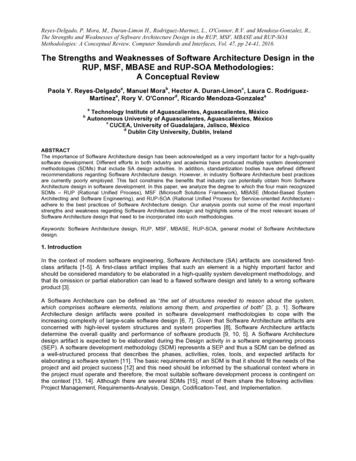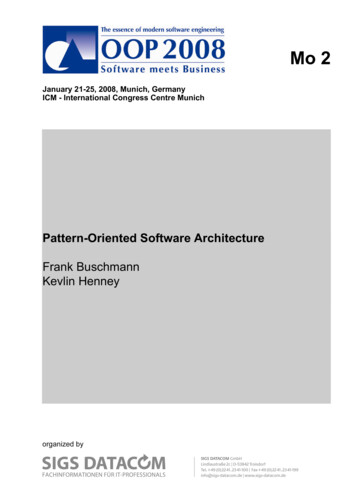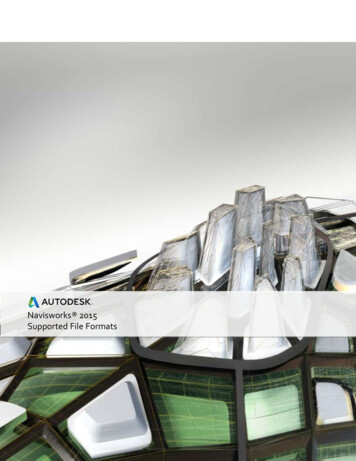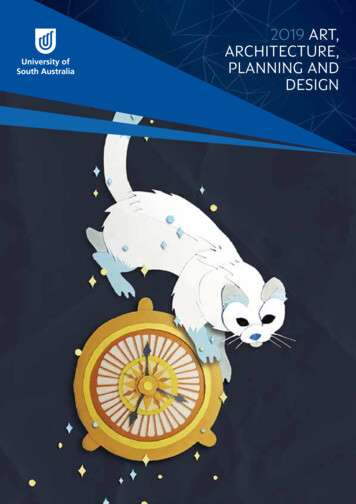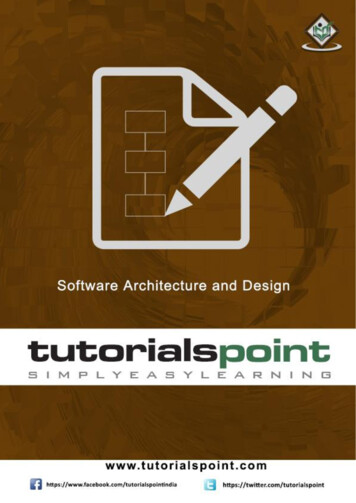
Transcription
i
About the TutorialSoftware Architecture typically refers to the bigger structures of a software system andit deals with how multiple software processes cooperate to carry out their tasks. SoftwareDesign refers to the smaller structures and it deals with the internal design of a singlesoftware process.By the end of this tutorial, the readers will develop a sound understanding of the conceptsof software architecture and design concepts and will be in a position to choose and followthe right model for a given software project.AudienceThis tutorial is designed for all software professionals, architects, and senior system designengineers. Managers of architecture teams will also benefit from this tutorial.PrerequisitesThere are no exact prerequisites for this tutorial. Any software professional can go throughthis tutorial to get a bigger picture of how high quality software applications and productsare designed.Copyright & Disclaimer Copyright 2016 by Tutorials Point (I) Pvt. Ltd.All the content and graphics published in this e-book are the property of Tutorials Point (I)Pvt. Ltd. The user of this e-book is prohibited to reuse, retain, copy, distribute or republishany contents or a part of the contents of this e-book in any manner without written consentof the publisher.We strive to update the contents of our website and tutorials as timely and as precisely aspossible, however, the contents may contain inaccuracies or errors. Tutorials Point (I) Pvt.Ltd. provides no guarantee regarding the accuracy, timeliness, or completeness of ourwebsite or its contents including this tutorial. If you discover any errors on our website orin this tutorial, please notify us at contact@tutorialspoint.comi
Software Architecture and DesignTable of ContentsAbout the Tutorial . iAudience . iPrerequisites . iCopyright & Disclaimer . iTable of Contents . ii1.SOFTWARE ARCHITECTURE AND DESIGN INTRODUCTION . 1Software Architecture . 1Software Design . 2Goals of Architecture . 2Role of Software Architect . 3Quality Attributes . 4Quality Scenarios . 52.SOFTWARE ARCHITECTURE AND DESIGN KEY PRINCIPLES . 7Architectural Style . 7Common Architectural Design . 7Types of Architecture . 8Architecture Design Process . 9Key Architecture Principles . 10Key Design Principles . 113.SOFTWARE ARCHITECTURE AND DESIGN ARCHITECTURE MODELS . 13UML . 13Architecture View Model . 15Architecture Description Languages (ADLs) . 174.SOFTWARE ARCHITECTURE AND DESIGN OBJECT-ORIENTED PARADIGM . 19ii
Software Architecture and DesignIntroduction to Object-Oriented Paradigm . 19OO Analysis . 22Object-Oriented Design . 235.SOFTWARE ARCHITECTURE AND DESIGN DATA FLOW ARCHITECTURE. 25Batch Sequential . 25Pipe and Filter Architecture. 26Process Control Architecture . 286.SOFTWARE ARCHITECTURE AND DESIGN DATA-CENTERED ARCHITECTURE . 30Types of Components . 30Repository Architecture Style . 31Blackboard Architecture Style . 327.SOFTWARE ARCHITECTURE AND DESIGN HIERARCHICAL ARCHITECTURE. 35Main-subroutine . 35Master-Slave . 36Virtual Machine Architecture . 38Layered Style . 398.SOFTWARE ARCHITECTURE AND DESIGN INTERACTION-ORIENTED ARCHITECTURE. 41Model-View-Controller (MVC) . 41Presentation-Abstraction-Control (PAC) . 449.SOFTWARE ARCHITECTURE AND DESIGN DISTRIBUTED ARCHITECTURE . 48Client-Server Architecture . 50Multi-Tier Architecture (n-tier Architecture) . 52Broker Architectural Style . 54Service-Oriented Architecture (SOA) . 56iii
Software Architecture and Design10. SOFTWARE ARCHITECTURE AND DESIGN COMPONENT-BASED ARCHITECTURE. 59What is a Component? . 59Principles of Component Based Design . 60Component-Level Design Guidelines . 61Conducting Component-Level Design . 6211. SOFTWARE ARCHITECTURE AND DESIGN USER INTERFACE . 64Graphical User Interface. 64Design of User Interface . 65User Interface Development Process . 66Design Considerations of User Interface. 6712. SOFTWARE ARCHITECTURE AND DESIGN ARCHITECTURE TECHNIQUES . 70Iterative and Incremental Approach. 70Architecture Review . 72Communicating the Architecture Design . 73iv
Software Architecture and Design1. Software Architecture and Design IntroductionThe architecture of a system describes its major components, their relationships(structures), and how they interact with each other. Software architecture and design is aprocess that includes several contributory factors such as Business strategy, qualityattributes, human dynamics, design, and IT environment.We can segregate Software Architecture and Design into two distinct phases: SoftwareArchitecture and Software Design. In Architecture, nonfunctional decisions are cast andseparated by the functional requirements. In Design, functional requirements areaccomplished.Software ArchitectureArchitecture serves as a blueprint for a system. It provides an abstraction to managethe system complexity and establish a communication and coordination mechanism amongcomponents. It defines a structured solution to meet all the technical and operationalrequirements, while optimizing the common quality attributes like performance andsecurity. It involves a set of significant decisions about the organization related to softwaredevelopment and each of these decisions can have a considerable impact onquality, maintainability, performance, and the overall success of the final product.These decisions comprise of:oSelection of structural elements and their interfaces by which the system iscomposed.1
Software Architecture and DesignoBehavior as specified in collaborations among those elements.oCompositionsubsystem.oArchitectural decisions align with business objectives.oArchitectural styles that guide the organization.of thesestructuralandbehavioralelements into largeSoftware DesignSoftware design provides a design plan that describes the elements of a system, howthey fit, and work together to fulfill the requirement of the system. The objectives ofhaving a design plan are as follows: To negotiate system requirements, and to set expectations with customers,marketing and management personnel. Act as a blueprint during the development process. Guide the implementation tasks, including detailed design, coding, integration, andtesting.It comes before the detailed design, coding, integration, and testing and after the domainanalysis, requirements analysis, and risk analysis.Goals of ArchitectureThe primary goal of the architecture is to identify requirements that affect the structure ofthe application. A well-laid architecture reduces the business risks associated with buildinga technical solution and builds a bridge between business and technical requirements.Some of the other goals are as follows: Expose the structure of the system, but hide its implementation details. Realize all the use-cases and scenarios. Try to address the requirements of various stakeholders.2
Software Architecture and Design Handle both functional and quality requirements. Reduce the goal of ownership and improve the organization’s market position. Improve quality and functionality offered by the system. Improve external confidence in either the organization or system.LimitationsSoftware architecture is still an emerging discipline within software engineering. It has thefollowing limitations: Lack of tools and standardized ways to represent architecture Lack of analysis methods to predict whether architecture will result in animplementation that meets the requirements. Lack of awareness of the importance of architectural design to softwaredevelopment Lack of understanding of the role of software architect and poor communicationamong stakeholders. Lack of understanding of the design process, design experience and evaluation ofdesignRole of Software ArchitectA Software Architect provides a solution that the technical team can create and design forthe entire application. A software architect should have expertise in the following areas:Design Expertise Expert in software design, including diverse methods and approaches such asobject-oriented design, event-driven design, etc. Lead the development team and coordinate the development efforts for theintegrity of the design. Should be able to review design proposals and tradeoffs among them.Domain Expertise Expert on the system being developed and plan for software evolution. Assist in the requirement investigation process assuring completeness andconsistency. Coordinate the definition of domain model for the system being developed.Technology Expertise3
Software Architecture and Design Expert on available technologies that helps in the implementation of the system. Coordinate the selection of programming language, framework, platforms,databases, etc.Methodological Expertise Expert on software development methodologies that may be adopted during SDLC(Software Development Life Cycle). Choose the appropriate approaches for development that helps the entire team.Hidden Role of Software Architect Facilitates the technical work among team members and reinforcing the trustrelationship in the team. Information specialist who shares knowledge and has vast experience. Protect the team members from external forces that would distract them and bringless value to the project.Deliverables of the Architect A clear, complete, consistent, and achievable set of functional goals A functional description of the system, with at least two layers of decomposition A concept for the system A design in the form of the system, with at least two layers of decomposition A notion of the timing, operator attributes, and the implementation and operationplans A document or process which ensures functional decomposition is followed, and theform of interfaces is controlledQuality AttributesQuality is a measure of excellence or the state of being free from deficiencies or defects.Quality attributes are system properties that are separate from the functionality of thesystem.Implementing quality attributes makes it is easier to differentiate a good system from abad one. Attributes are overall factors that affect runtime behavior, system design, anduser experience. They can be classified as follows:Static Quality AttributesReflect the structure of system and organization, directly related to architecture, design,source code. They are invisible to end-user, but affect the development and maintenancecost, e.g.: modularity, testability, maintainability, etc.4
Software Architecture and DesignDynamic Quality AttributesReflect the behavior of the system during its execution. They are directly related tosystem’s architecture, design, source code and also the configuration, deploymentparameters, environment, and platform.They are visible to the end-user and exist at runtime, e.g.: throughput, robustness,scalability, etc.Quality ScenariosQuality scenarios specify how to prevent a fault from becoming a failure. They can bedivided into six parts based on their attribute specifications: SourceAn internal or external entity such as people, hardware, software, orphysical infrastructure that generates the stimulus. Stimulus Environment ArtifactA whole system or some part of it such as processors, communicationchannel, persistent storage, processes etc. ResponseAn activity undertaken after the arrival of stimulus such as detectfaults, recover from fault, disable event source etc. Response measureShould measure the occurred responses so that therequirements can be tested.A condition that needs to be considered when it arrives on a system.The stimulus occurs within certain conditions.Common Quality AttributesThe following table lists the common quality attributes a software architecture must ptionConceptualIntegrityDefines the consistency and coherence of theoverall design. This includes the way componentsor modules are designedMaintainabilityAbility of the system to undergo changes with adegree of ease.ReusabilityDefines the capability for components andsubsystems to be suitable for use in otherapplicationsInteroperabilityAbility of a system or different systems to operatesuccessfully by communicating and exchanging5
Software Architecture and Designinformation with other external systems writtenand run by external ityDefines how easy it is for system administrators tomanage the applicationReliabilityAbility of a system to remain operational over timeScalabilityAbility of a system to either handle increases inload without impact on the performance of thesystem, or the ability to be readily enlarged.SecurityCapability of a system to prevent malicious oraccidental actions outside of the designed usagesPerformanceIndication of the responsiveness of a system toexecute any action within a given time interval.AvailabilityDefines the proportion of time that the system isfunctional and working. It can be measured as apercentage of the total system downtime over apredefined period.SupportabilityAbility of the system to provide information helpfulfor identifying and resolving issues when it fails towork correctly.TestabilityMeasure of how easy it is to create test criteria forthe system and its componentsUserQualitiesUsabilityDefines how well the application meets therequirements of the user and consumer by tability for satisfying all the requirements ofthe system.PortabilityAbility of the system to run under differentcomputing environment.IntegralityAbility to make separately developed componentsof the system work correctly together.ModifiabilityEase with which each software system canaccommodate changes to its software.Cost andscheduleCost of the system with respect to time to market,expected project lifetime & utilization of legacyMarketabilityUse of system with respect to market butes6
Software Architecture and Design2. Software Architecture and Design Key PrinciplesSoftware architecture is described as the organization of a system, where the systemrepresents a collection of components that accomplish a specific set of functions.Architectural StyleThe architectural style, also called as architectural pattern, is a set of principles whichshapes an application. It defines an abstract framework for a family of system in terms ofthe pattern of structural organization. The architectural style Provides a lexicon of components and connectors with rules on how they can becombined. Improves partitioning and allows the reuse of design by giving solutions tofrequently occurring problems. Describes a particular way to configure a collection of components (a module withwell-defined interfaces, reusable, replaceable) and connectors (communication linkbetween modules).The software that is built for computer-based systems exhibit one of many architecturalstyles. Each style describes a system category that encompasses: A set of component types which perform a required function by the system A set of connectors (subroutine call, remote procedure call, data stream, socket)that enable communication, coordination, and cooperation among components Semantic constraints which define how components can be integrated to form thesystem A topological layout of the components indicating their runtime interrelationshipsCommon Architectural DesignThe following table lists architectural styles that can be organized by their key focus area.CategoryArchitecturalDesignMessage busDescriptionPrescribes use of a software system that canreceive and send messages using one ormore communication channels7
Software Architecture and DesignCommunicationService–OrientedArchitecture (SOA)Client/serverDeployment3-tier or N-tierDomainSeparate the system into two applications,where the client makes requests to theserverSeparates the functionality into separatesegments with each segment being a tierlocated on a physically separate computer.Domain DrivenDesignFocused on modeling a business domain anddefining business objects based on entitieswithin the business domain.ComponentBreakdown the application design intoreusable functional or logical componentsthat expose well-defined communicationinterfaces.BasedStructureDefines the applications that expose andconsume functionality as a service usingcontracts and messages.LayeredDivide the concerns of the application intostacked groups (layers).Object orientedBased on the division of responsibilities of anapplication or system into objects, eachcontaining the data and the behaviorrelevant to the object.Types of ArchitectureThere are four types of architecture from the viewpoint of an enterprise and collectively,these architectures are referred to as enterprise architecture. Business architecture: Defines the strategy of business, governance,organization, and key business processes within an enterprise and focuses on theanalysis and design of business processes. Application (software) architecture: Serves as the blueprint for individualapplication systems, their interactions, and their relationships to the businessprocesses of the organization Information architecture: Defines the logical and physical data assets and datamanagement resources. Information technology (IT) architecture: Defines the hardware and softwarebuilding blocks that make up the overall information system of the organization.8
Software Architecture and DesignArchitecture Design ProcessThe architecture design process focuses on the decomposition of a system intocomponents and their interactions to satisfy functional and nonfunctional requirements.The key inputs to software architecture design are: The requirements produced by the analysis tasks The hardware architecture (the software architect in turn provides requirements tothe system architect, who configures the hardware architecture)The result or output of the architecture design process is an architectural description.The basic architecture design process is composed of the following steps:Understand the Problem This is the most crucial step because it affects the quality of the design that follows. Without a clear understanding of the problem, it is not possible to create aneffective solution. Many software projects and products are considered failures because they did notactually solve a valid business problem or have a recognizable return on investment(ROI).Identify Design Elements and their Relationships In this phase, build a baseline for defining the boundaries and context of thesystem. Decomposition of the system into its main components based on functionalrequirements. The decomposition can be modeled using a design structure matrix(DSM), which shows the dependencies between design elements without specifyingthe granularity of the elements. In this step, the first validation of the architecture is done by describing a numberof system instances and this step is referred as functionality based architecturaldesign.Evaluate the Architecture Design Each quality attribute is given an estimate so in order to gather qualitativemeasures or quantitative data, the design is evaluated. It involves evaluating the architecture for conformance to architectural qualityattributes requirements. If all estimated quality attributes are as per the required standard, the architecturaldesign process is finished. If not, the third phase of software architecture design is entered: architecturetransformation. If the observed quality attribute does not meet its requirements,then a new design must be created.9
Software Architecture and DesignEnd of ebook previewIf you liked what you saw Buy it from our store @ https://store.tutorialspoint.com10
Software architecture and design is a process that includes several contributory factors such as Business strategy, quality attributes, human dynamics, design, and IT environment. We can segregate Software Architecture and Design into two di

